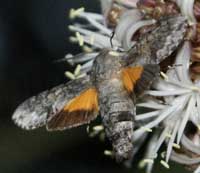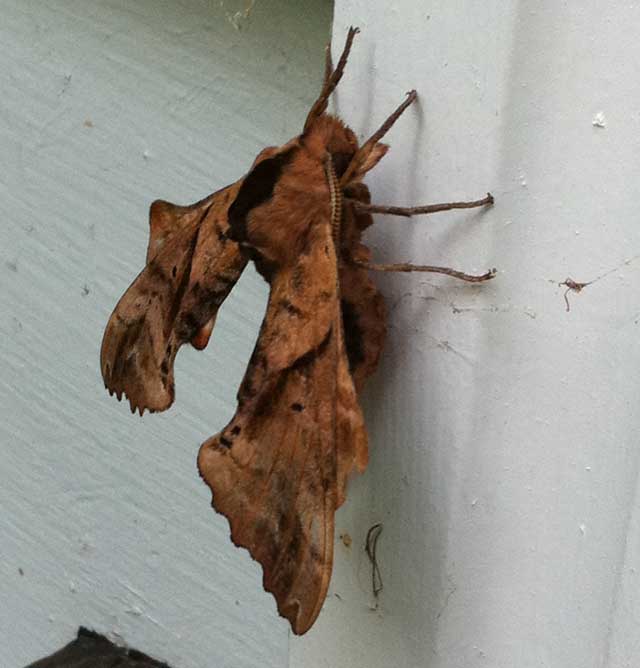Sphinginae subfamily
Sphingini tribe:
 |
This moth is a very strong flier, but would only make its way to
Ulster County as a rare stray. There are not too many records from
New York state, but records exist for NJ and CT.
only as a very rare stray
|
 |
Ceratomia amyntor
BAM,
the Elm Sphinx or Four-horned Sphinx
The upperside of the forewing is brown with dark brown and white markings including a white costal area near the
wing base, dark streaks along the veins, and a white spot in the cell.
Larvae feed on Elm (Ulmus), birch (Betula), basswood (Tilia), and
cherry (Prunus). |
 |
This is generally a more southerly species, but it has been recorded
in Suffolk.
I saw them in great numbers in New Jersey. The larvae feed in large groups and are much more
spectacular than the moths.
Catalpa is the larval host. Generally more southerly |
 |
The upperside of the forewing is pale brownish gray with wavy black
and white lines and a black-outlined white cell spot. The upperside
of the hindwing is gray with diffuse darker bands.
|
 |
The upperside of the forewing is dark brown with a dusting of white
scales. Some moths have patches of reddish or yellowish brown on the
wings.
|
 | The upperside of the forewing is gray with heavy black bands. The upperside of
the hindwing is brownish gray with no markings.
|
 |
The upperside is of the forewing is gray with two
(sometimes one or three) black dashes near the wing center; other markings are usually diffuse. The upperside of the hindwing is a uniform brown-gray.
If you've got pines, this species is likely present.
|
 |
Lintneria eremitus
WO, the
Hermit Sphinx.
The upperside of the forewing is gray-brown with wavy lines,
black dashes, and one or two small white spots near the center of
the costa. The upperside of the hindwing is black with two white
bands and a triangular black patch at the base. Note the golden hair
on the thorax.
|
 |
The upperside of forewing is gray to grayish brown with a black line
running from the middle of the costa to the middle of the outer
margin; the line may be broken near the margin. There is a splash of
brown around the cell spot.
|
 |
Manduca quinquemaculatus
BAM,
the Five-spotted Hawkmoth,
The moth abdomen usually has five but sometimes six pairs of
yellow bands. The upperside of the forewing is blurry brown and
gray. The upperside of the hindwing is banded with brown and white
and has two well-separated median zigzag bands.
|
 |
If you grow tomatoes, you have probably encountered Manduca sexta
in the larval stage.
Larvae get very large and can strip a tomato plant.
|
 | The upperside of the forewing is gray with indistinct black and
white markings. There is a series of black dashes
from the base to the tip, and a small white cell spot. possibility
|

|
Sphinx canadensis
WO,
Sphinx canadensis, the Canadian Sphinx, is not common, and is not
often reported anywhere, but it might possibly be present in Washington County.
Larval hosts are white ash (Fraxinus americana) and blueberry
(Vaccinium).
|
 |
Sphinx chersis
BAM, the Northern Ash Sphinx or Great Ash
Sphinx
The upperside of the forewing is soft dark gray to blue-gray with a series of black dashes, one of which reaches the wing tip.
The upperside of the hindwing is black with blurry pale gray bands.
|
 |
Forewings, long and slender, are held close to the body when the
moth is at rest.
|
 | The upperside of the forewing ranges from brown with
black borders through brownish gray with paler borders to pale gray
with no borders. Dashes, submarginal line, and cell spot are usually
weak. possibility
|
 |
The lower forewings are predominantly brownish-yellow with a fairly
wide dark bar along the inner margin. At rest the wings hug the
body, giving the moth a long slender look.
|
 |
Sphinx luscitiosa
WO,
the Canadian Sphinx or Clemen's Sphinx
The upperside of the forewing is yellowish gray in males and pale gray with a faint yellow tint in females. In both sexes, the dark border on the outer margin
widens as it approaches the inner margin.
|
 |
If you have blueberries in the woods, then you probably have the
Poecila Sphinx.
They are pretty common here on Prince Edward Island, and
I suspect might be present around blueberry
fields in Westchester County. |
Smerinthini Tribe:
 |
Amorpha juglandis
WO, the Walnut Sphinx
The adults are also highly variable; sometimes wings of an individual may be all one color or may have several colors, ranging from pale to dark brown,
and may have a white or pink tinge.
This is the first Sphinx species I reared as a boy in New Jersey.
See the file for the female; she is different. |
 |
Pachysphinx modesta
WO,
the Modest Sphinx or Poplar Sphinx
This moth has a large, heavy body, and females can be remarkably plump.
They are common on Prince Edward Island. I rear some almost every year. |
 |
Paonias astylus flies from March-September in Florida and from
April-September in Louisiana. There is one brood northward from
June-August.
This appears to be an uncommon species. unlikely possibility
|
 |
Named for the dull grey-blue spot (minus dark pupil) in the hindwing,
this moth has a wide distribution and is probably common in
Ulster County.
I regularly see them on Prince Edward Island, and they are reported
as far south as Florida. |
Paonias excaecata, July 27, 2011, Michael and Maggie Reed
 |
Paonias myops
BAM/SK, the Small-eyed Sphinx
Named for the small eye-spot in the hindwing, this moth has a wide
distribution and is probably common in your county.
I regularly see them on Prince Edward Island in eastern Canada, and they are reported
as far south as Florida.
|
Paonias myops, Pelham, June 9, 2012, Steve K.
 |
Smerinthus cerisyi
WO, the Cerisyi's Sphinx
Smerinthus cerisyi, the one-eyed sphinx or Cerisyi's sphinx,
(wingspan approximately 95mm) closely resembles Smerinthus jamaicensis, and
in northern regions the two species overlap. This is a very easy
Sphinx to rear. possibility
|
 |
Smerinthus jamaicensis closely resembles Smerinthus cerisyi, but jamaicensis is much smaller with larger blue patches on more
vibrant and deeper purple in the lower wings.
|
Macroglossinae subfamily
Dilophonotini tribe:
See Hemaris comparison to help distinguish
the next three species.
 |
Hemaris diffinis
BAM, the Snowberry Clearwing or Bumblebee Moth
This moth is widely distributed and has been reported to the north,
east, south and west.
|
 |
Hemaris gracilis BAM, the
Slender Clearwing or Graceful Clearwing
Hemaris gracilis is distinguished from similar species by a pair of red-brown bands on the undersides of the thorax, which varies from green to yellow-green dorsally and sometimes brown with white underneath. They have a red abdomen.
|
 |
Hemaris thysbe
BAM, the Hummingbird Clearwing
It is not difficult to see why many gardeners would mistake an Hemaris thysbe moth for a small hummingbird as it hovers, sipping nectar from flowers through a long feeding tube.
|
Philampelini tribe:
 |
Note the differences between this moth and the Pandorus Sphinx.
|
 |
If you have Grape or Virginia Creeper nearby, then you might have
this species.
I often get asked to identify larvae from areas not
previously reported.
|
Macroglossini tribe:
 |
This day flier is widely distributed in New York. The adult Nessus sphinx,
which flies during the day and at dusk, has two bright yellow bands
on the tufted abdomen.
|
Amphion floridensis, Bronxville, June 4, 2012, Andrew Block.
 |
This species is rarely recorded in the U.S., but there are sightings in the east
from Florida, South Carolina, New Jersey, New York, Massachusetts and
New Hampshire.
There are no reports from Suffolk. Questionable!
|
 |
They are common in New Jersey and common
here on Prince Edward Island.
You will often see this species listed as Darapsa pholus,
especially in older literature. |
 |
Darapsa myron
WO, the Virginia Creeper Sphinx or the
Grapevine Sphinx
It is widely reported from Florida as far north as southern Maine. If
you have the foodplants indicated in the common names, you probably have this
species nearby. |
 |
If you have hydrangea growing near a stream, then you may have the
Hydrangea Sphinx.
|
 |
This species has been recorded in eastern and western New York,
and has been reported to the south so should be present. It is
generally absent to the north so would be uncommon, although
I have reports from Ontario, Canada. |
 |
Hyles gallii
WO, the Bedstraw Hawk Moth
or Gallium Sphinx
Hyles gallii ranges coast to coast in Canada (into the Yukon) and
southward along the Rocky Mountains into Mexico. It is also widely
distributed throughout Europe and Asia.
|
 |
Hyles lineata
BAM, the White-lined Sphinx
The forewing upperside is dark olive brown with paler brown
along the costa and outer margin, a narrow tan band running from
the wing tip to the base, and white streaks along the veins. |
 |
This moth is very much under reported across the United States. It
is a rapid day flier so is probably not in too many collections.
Grape is a popular larval host.
|
|
|
|


